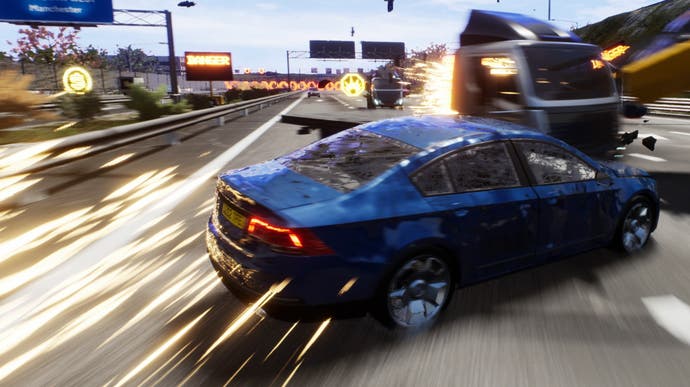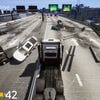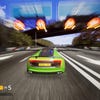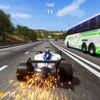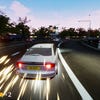Danger Zone 2 is the next step toward the Burnout successor we've been waiting for
Crash-testing the new game from Criterion's founders.
The spiritual successor to Burnout we've been waiting for is coming - but perhaps not quite in the way you might have imagined. Danger Zone 2, a current-gen revamp of Burnout's crash mode, arrives on July 13th on PlayStation 4, Xbox One and PC, courtesy of Three Fields Entertainment. Meanwhile, further on down the road, Dangerous Driving is the circuit-based Burnout successor that follows it, arriving as soon as this winter - and developed by the same close-knit team of just seven people.
Stacked up against the first Danger Zone released last year, the sequel represents a radical improvement in every way. First of all, the constrained indoor environments of the series opener are replaced with a range of outdoor, real-life locations including LAX, Spaghetti Junction, the Kennedy interchange in Kentucky and even the M62 just outside Leeds. But what's clear from the visual language is that these are very much stylised interpretations - seen through lens of a Sega-style 'blue skies' aesthetic, along with the arcade-style design of Burnout itself.
The expanded scope of the stages in Danger Zone 2 also hints at the track racing game to come. For starters, this game isn't just about crashing, although obviously it is the primary focus - the cars now have boost, and there's a couple of survival mode races in there, designed for pinpoint precision driving where preserving the boost chain yields maximum scores. Then there's the implementation of traffic checking from Burnout Revenge - only this time, the function gets a showcase workout by putting the player behind the wheel of a big rig, smashing your way through traffic before arriving - and detonating - at the Danger Zone. As there's often a degree of racing or checking en route to the crash site, a distance countdown meter is present and the eponymous danger zone is clearly highlighted, so you know when and where to go 'boom'.
The quality of the carnage is certainly satisfying - using and improving upon the existing physics engine seen in Dangerous Golf and Danger Zone, with the shiny bits once again provided by Unreal Engine 4. It's a middleware that serves small indie developers well, with TFE telling me that the quality of the technology - particularly on the Xbox side - has increased significantly owing to the vast resources Epic itself is pouring into the engine to support Fortnite.
Some of the particular hallmarks of the engine are noticeable: over and above the signature way that materials and lighting are rendered, UE4's excellent temporal anti-aliasing is deployed, smoothing off the edges and providing scalability on the lower-end builds of the game. Similar to the way Fortnite presents across multiple platforms, the base Xbox One version looks similar to the top-end X release - just somewhat blurrier with a target 900p resolution (expect 1080p on PS4 and circa-1500p on Pro). Other Fortnite tech is also used in Danger Zone 2 - Epic's tree imposter technique is also used, swapping out GPU-intensive geometry for simpler, but uncannily similar shapes when viewed at a distance. GPU-accelerated particles also serve to emphasise collisions, checking and side-swiping.
Also present is UE4's recently introduced dynamic resolution scaler, aimed at trading pixels for performance where needed. However, on Xbox One X at least, optimisation was based on a native 4K output, with DRS only added at the end of development. Physics are entirely CPU-driven, so in common with Dangerous Golf and the first Danger Zone, this is a 30Hz experience on all consoles bar Xbox One X, which has an optional unlocked performance mode that while not perfectly consistent, effectively trades physical resolution for temporal, offering a smoother ride and an experience that is closer to the feel of the original Burnout.
And it's clear that a lot of Three Fields' efforts are under the hood - and they aren't just there to make Danger Zone 2 better, but implemented with an eye towards the game to come. It's been clear from the developer's first game - and its prior Burnout experience - that it knows Crash Mode intimately: how to create the intricate puzzles, where to place the bonus icons, how to signal to the player what they should be doing to achieve the maximum scores. But in the here and now, key Burnout staples are starting to fall into place - boost chains, survival laps and satisfying handling embellish the game we have here, but will clearly play a much larger role in the game to follow.
And behind it all is the reality of indie development. Rather than spend two years developing a game like Dangerous Golf, the emphasis has shifted for Three Fields to a more fluid, rolling model of evolution - a stark contrast to the Burnout games, where the core tech was effectively rebuilt with every release. So, for example, moving from indoor crash test zones to real-life outdoor locations in Danger Zone 2 required a new spline-based track editor that allowed for quick level development and rapid iteration times. And that tool will form the basis of the editor required for the full circuit-based racing promised for Dangerous Driving. Similarly, Danger Zone 2 has a decent range of vehicles that add variety to the game (from trucks to hypercars to sports saloons) which will also be retained for Dangerous Driving, where they'll play a different role in a Burnout-style racing game.
But at the same time, what it also means is that the months of polish sunk into a triple-A release simply isn't viable for the product of a much smaller team - and this is felt with the game. There is a little hitching and stuttering, the UI is basic but functional and sometimes the level of carnage your vehicle goes through doesn't feel fully reflected in its damage model. But it's clear that most of the team's focus has been on focusing on the fundamentals like scaling up the levels, improving the handling and most crucially, delivering a fun experience. After playing this, returning to the first Danger Zone was instructional: the sequel delivers a massive leap in terms of both look and feel while also tapping deeper into the team's experience in creating arcade racing games.
Danger Zone 2 plays heavily on Burnout nostalgia then, and that's not a bad thing. Everyone has their own favourite Burnout game and it's a series where the most intense moments almost feel like they're burned into your gaming DNA. For me, it's an insane, impossible fluke of a 90 degree drift around a junction in the roadster in Burnout 1, threading through traffic. Or sitting back and chuckling the first time I saw Burnout 3's takedowns and the beautiful way in which they were presented. And then there's Burnout Revenge and the carnival of in-game destruction caused by checking - a controversial addition to the series, but one that I loved.
Danger Zone 2 may not have the takedown cameras, but it has the shunting, the drifting and the checking - but using a truck to power through traffic to punt vehicles across a wide bridge into areas I couldn't reach myself did two things for me: it recaptured something of the original game that I connected with, but also served to do something new with it. And that's that's something that I really wanted from the Burnout sequel that never happened - and that hopefully we'll see in the upcoming Dangerous Driving.
